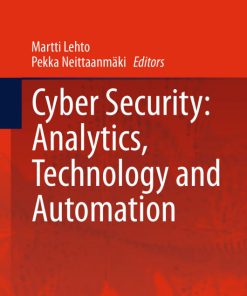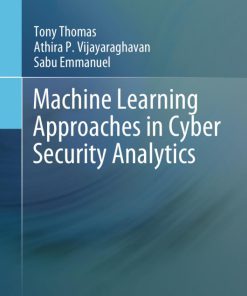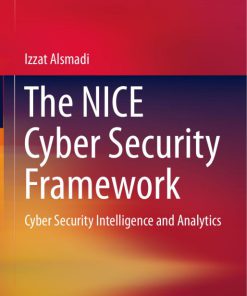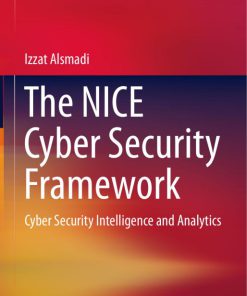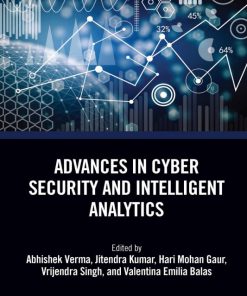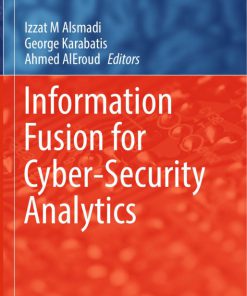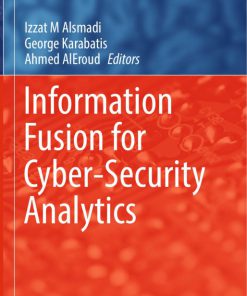Cyber Security Analytics Technology and Automation 1st Edition by Martti Lehto, Pekka Neittaanmaki ISBN 9783319183022 3319183028
$50.00 Original price was: $50.00.$25.00Current price is: $25.00.
Authors:Martti Lehto; Pekka Neittaanmäki , Series:IT & Computer [298] , Tags:Computers; Security; General; Technology & Engineering; Telecommunications; Engineering (General); Information Technology; Fire Science; www.it-ebooks.info , Author sort:Lehto, Martti & Neittaanmäki, Pekka , Ids:Google; 9783319183022 , Languages:Languages:eng , Published:Published:May 2015 , Publisher:Springer , Comments:Comments:The book, in addition to the cyber threats and technology, processes cyber security from many sides as a social phenomenon and how the implementation of the cyber security strategy is carried out.The book gives a profound idea of the most spoken phenomenon of this time. The book is suitable for a wide-ranging audience from graduate to professionals/practitioners and researchers. Relevant disciplines for the book are Telecommunications / Network security, Applied mathematics / Data analysis, Mobile systems / Security, Engineering / Security of critical infrastructure and Military science / Security.
Cyber Security Analytics Technology and Automation 1st Edition by Martti Lehto, Pekka Neittaanmaki – Ebook PDF Instant Download/Delivery. 9783319183022 ,3319183028
Full download Cyber Security Analytics Technology and Automation 1st Edition after payment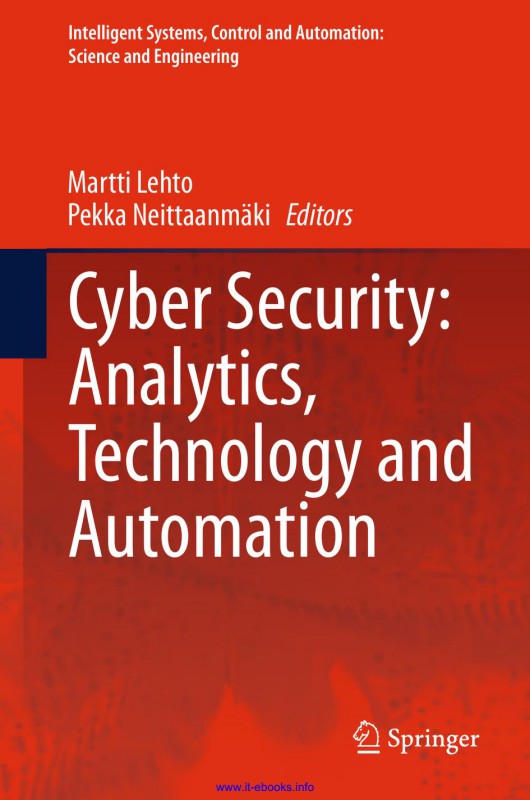
Product details:
ISBN 10: 3319183028
ISBN 13: 9783319183022
Author: Martti Lehto, Pekka Neittaanmaki
Cyber Security Analytics Technology and Automation 1st Edition Table of contents:
1 Phenomena in the Cyber World
Abstract
1 What Does `Cyber’ Mean?
2 Drivers of Change in the Cyber World
3 Cyber Threats and Vulnerabilities
3.1 Cyber Threats
3.2 Cyber Activism
3.3 Cybercrime
3.4 Cyber Espionage
3.5 Cyberterrorism
3.6 Cyber Warfare
3.7 Cyber World Vulnerabilities
3.8 Cyber Operations
3.9 Cyber Weaponry
3.10 Society’s Critical Structures as Targets
3.10.1 Critical Infrastructure
3.11 Critical Information Infrastructure
3.12 Scada
4 Cyber Security
References
2 Cyber World as a Social System
Abstract
1 Introduction
2 Concepts
2.1 The Main Concepts of the Cyber World
2.2 The Physical and the Cyber World Framework
3 System Modeling Approaches on the Cyber World
3.1 The Cyber World as a Complex Adaptive System
3.2 The Content Analysis of the Cyber World
3.3 A Social System Model as a Worldview to the Cyber World
4 The Content Analysis of the Cyber World
4.1 Media Surveys
4.2 Information Assurance
5 Conclusions
References
3 Citizens in Cyber World—Despatches from the Virtual “Clinic”
Abstract
1 Introduction
2 Theory and Method
3 Preparing for Mental Battles in the Virtual Clinic
4 Ego’s Habituation into the Past Narratives and Myths
5 Impenetrable and Paranoid Defence of the Ego
6 Penetrable and Protean Ego
7 Discussion
References
4 Powers and Fundamental Rights in Cyber Security
Abstract
1 Introduction
2 Constitutional Protection of Personal Data and Confidential Communications
3 The Powers of Communications Authority
4 The Activities of NCSC-FI
5 The Powers of Police in Cyber Space
6 The Powers in Escalated Threats
References
Part II Cyber Security Threats, Legalityand Strategy
5 Coder, Hacker, Soldier, Spy
Abstract
1 Introduction
2 Cyber Espionage
3 Cyber Crime
4 Cyber Activism
5 Cyber Terrorism
6 Cyber War
7 Conclusion
References
6 Cyber Warfare
Abstract
1 Introduction
2 Cyber Warfare from the Perspective of International Law
3 Cyber Warfare as a Military Capability
4 Conclusion
References
7 Deception in the Cyber-World
Abstract
1 Introduction: Setting the Scene
2 Why Deception?
3 The Cyber-World: Another Dimension
4 The Strategic Use of Deception in the New World
5 Old Style Cyber-Deception: New Style Cyber-Deception
6 Networked Robots
7 Summary
References
8 Legal Framework of Cyber Security
Abstract
1 Introduction
2 Cyber Security from a Legal Perspective
3 Instruments and Areas of Law Addressing Cyber Security
4 Implications of Diminishing Legal Certainty
5 Conclusion
References
9 Finnish Cyber Security Strategy and Implementation
Abstract
1 Introduction
2 Comprehensive Security
3 Cyber Security as a Part of Comprehensive Security
4 Cyber Security Strategy
5 Generic Cyber Strategy Process
5.1 Character of the Process
5.2 Strategic Analysis
5.3 Strategic Priority
5.4 Implementing the Strategy
6 Finnish Implementation and Steering Process
References
Part III Cyber Security Technology
10 Clustering-Based Protocol Classification via Dimensionality Reduction
Abstract
1 Introduction
2 Related Work and Mathematical Background
2.1 Dimensionality Reduction
2.1.1 Diffusion Maps (DM)
2.1.2 Geometric Harmonics
2.2 Clustering Techniques
2.2.1 k-Means and Its Derivatives
3 Evaluation Datasets
4 Traffic Analyzer
5 Sequential Application of the Flow-Oriented Traffic Analyzer
6 Clustering-Based Protocol Classification via Dimensionality Reduction
6.1 Outline of the Real-Time Protocol Classification Process
6.1.1 High Level Description of the PCR Algorithm
6.1.2 Detailed and Formal Description of the PCR Algorithm
7 Experimental Results
7.1 Protocol Classification and Recognition
7.1.1 Experimental Results on Training Datasets
The Inter-Cluster Accuracy Results from the PCR Algorithm
The Inter-Cluster Covers Results from the Classification Algorithm
7.1.2 Experimental Results on Testing Datasets
7.2 UCI Datasets
8 Conclusion
References
11 Timing and Side Channel Attacks
Abstract
1 Introduction
2 Hypervisor Blue Pills and Red Pills
2.1 Subverting and Blue Pill Concept
2.2 Local Hypervisor Red Pills—Direct and Sub-channel Attack
2.3 Remote Hypervisor Red Pills
3 Invisible Character Differences
4 Timing Attacks
4.1 GameCube DVD Password Attack
5 AES Side-Channel Attacks
5.1 AES Background
5.2 AES Software Implementation
5.3 Cache Memory
5.4 Side Channel Attacks on AES
6 Power Based Attacks
References
12 Knowledge Discovery from Network Logs
Abstract
1 Network Anomaly Detection
1.1 Fingerprinting
1.2 Anomaly Detection
2 Network Environment
3 Knowledge Discovery Process
3.1 Databases
3.2 Selection
3.3 Preprocessing
3.4 Transformation
3.5 Data Mining
3.6 Interpretation and Evaluation
4 Some Proposed Approaches
5 Conclusion
References
13 Trusted Computing and DRM
Abstract
1 Ethics—Trusted or Treacherous Computing
2 The Trusted Processing Module by TCG
2.1 Remote Attestation
2.2 Direct Anonymous Attestation
3 Intel TXT and AMD/ARM Trustzone
4 Other Architectures for “Trusted Computing”
4.1 HDMI and HDCP and Its Predecessors
4.2 Macrovision, CSS and DeCSS
4.3 HDMI and HDCP
5 Other Uses for Trusted Computing
6 Attacks on Trusted Computing
7 Beyond Trust—SGX
References
Part IV Cyber Security and Automation
14 Cyber Security and Protection of ICS Systems: An Australian Example
Abstract
1 Introduction
2 ICS Security
3 Maroochy SCADA Security Case Study
4 Australian Strategic Cyber Protection
5 Discussion
5.1 Policy
5.2 Business Drivers
5.3 Technical Issues
6 Conclusion
References
15 Towards Dependable Automation
Abstract
1 Introduction
2 Towards Dependable Automation
3 Time Dependence in Automation
4 Security Challenges
5 Securing Automation Lifecycle
6 Guideline for Dependable Automation
6.1 Create an Essential Model Through Business Analysis
6.2 Define the Use Case Explicitly
6.3 Determine the Participating Information Systems
6.4 Define the Orchestration of the Process
6.5 Define and Implement Processes
6.6 Define Data Flows
6.7 Define the Information Content of Data Flows
6.8 Create Dependability Models
6.9 Choose Information Security Implementation Methods
6.10 Implement the Solution/Orchestration
7 Securing Development
8 Dependability Model
9 PICARD Extension
10 Securing the Purchases
11 Securing the Operations
12 Securing the Disposal
13 Conclusions
References
16 Specialized Honeypots for SCADA Systems
Abstract
1 Introduction
2 Security of Industrial Control Systems
3 The Role of Honeypots Within SCADA Systems
4 Proposed Architecture of the SCADA Network Honeypot
4.1 Honeypot Front-End Interface
4.2 Event Monitor
4.3 Honeypot Management and Watchdog
4.4 Firewall
4.5 Usage of SNMP in SCADA Environments
5 Implementation and Deployment Notes
5.1 SCADA Honeypot as a Low Cost Hardware Appliance
5.2 SCADA Honeypot as Virtualized Appliances
5.3 Alternative Architecture for a High-Interaction Honeypot
6 Conclusion
Acknowledgments
References
People also search for Cyber Security Analytics Technology and Automation 1st Edition:
use of ai in business analytics
what is analytics technology
analytics and automation
data analytics and automation






